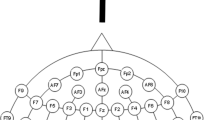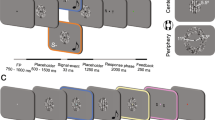Abstract
HUMAN listeners can localize sounds by the difference in both arrival time (phase) and loudness between the two ears1. Movement of the sound source modulates these cues, and responses to moving sounds have been detected in animals in primary auditory cortex2,3 and in humans in other cortical areas4. Here we show that detection of changes in the interaural phase or amplitude difference occurs through a mechanism distinct from that used to detect changes in one ear alone. Moreover, a patient with a right hemisphere stroke is unable to detect sound movement, regardless of whether it is defined by phase or by loudness cues. We propose that this deficit reflects damage to a distinct cortical area, outside the classical auditory areas, that is specialized for the detection of sound motion. The deficit is analagous to cerebral akinotopsia (motion blindness) in the visual system, and so the auditory system may, like the visual system5, show localization of specialized functions to different cortical regions.
This is a preview of subscription content, access via your institution
Access options
Subscribe to this journal
Receive 51 print issues and online access
$199.00 per year
only $3.90 per issue
Buy this article
- Purchase on Springer Link
- Instant access to full article PDF
Prices may be subject to local taxes which are calculated during checkout
Similar content being viewed by others
References
Lord Rayleigh Phil. Mag. 13, 214–232 (1907).
Stumpf, E., Toronchuk, J. M. & Cynader, M. S. Exp. Brain Res. 88, 158–168 (1991).
Ahissar, M., Ahissar, E., Bergman, H. & Vaadia, E. J. Neurophysiol. 67, 203–215 (1992).
Griffiths, T. D., Bench, C. J. & Frackowiak, R. S. J. Curr. Biol. 4, 892–895 (1994).
Watson, J. et al. Cered. Cortex 3, 79–94 (1993).
Kay, R. H. & Mathews, D. R. J. Physiol. (Lond.) 225, 657–677 (1972).
Moore, B. C. J., Glasberg, B. R. & Gaunt, T. Q. J. Exp. Psychol. 43A, 327–347 (1991).
Blauert, J. Spatial Hearing. The Psychophysics of Human Sound Localisation (MIT Press, Cambridge, MA, 1983).
Rizzo, M., Nawrot, M. & Zihl, J. Brain 118, 1105–1127 (1995).
Zihl, J., von Cramon, D. & Mai, N. Brain 106, 313–340 (1983).
Strybel, T., Manligas, C. L. & Perrott, D. R. Percept. Psychophys. 45, 371–377 (1989).
Jeffress, L. A. J. Comp. Physiol. Psychol. 41, 35–39 (1948).
Grantham, D. W. & Wightman, F. L. Percept. Psychophys. 26, 403–408 (1979).
Perrott, D. R. & Tucker, J. J. Acoust. Soc. Am. 83, 1522–1527 (1988).
Lauter, J. L., Herscovitch, P., Formby, C. & Raichle, M. E. Hear. Res. 20, 199–205 (1985).
Pardo, P., Makela, J., Sams, M. & Hari, R. Soc. Neurosci. Abstr. 20, 325 (1994).
Whitfield, I. & Evans, E. J. Neurophysiol. 28, 655–672 (1965).
Altman, J. A. & Kalmykova, I. V. Hear. Res. 24, 243–253 (1986).
Anderson, R. A. Cereb. Cortex. 5, 457–469 (1995).
Lavikainen, J., Houtilainen, M., Pekkonen, E., llmoniemi, R. J. & Naatanen, R. NeuroReport 6, 182–184 (1994).
Pinek, B. & Brouchon, M. Brain Cogn. 11, 1–11 (1992).
MacMillan, N. A. & Creelman, C. D. Detection Theory: A User's Guide (Cambridge Univ. Press, 1991).
Author information
Authors and Affiliations
Rights and permissions
About this article
Cite this article
Griffiths, T., Rees, A., Witton, C. et al. Evidence for a sound movement area in the human cerebral cortex. Nature 383, 425–427 (1996). https://doi.org/10.1038/383425a0
Received:
Accepted:
Issue Date:
DOI: https://doi.org/10.1038/383425a0
This article is cited by
-
Effective sound detection system in commercial car vehicles using Msp430 launchpad development
Multimedia Tools and Applications (2023)
-
Motion-onset auditory-evoked potentials critically depend on history
Experimental Brain Research (2010)
-
Right parietal cortex is involved in the perception of sound movement in humans
Nature Neuroscience (1998)
Comments
By submitting a comment you agree to abide by our Terms and Community Guidelines. If you find something abusive or that does not comply with our terms or guidelines please flag it as inappropriate.



